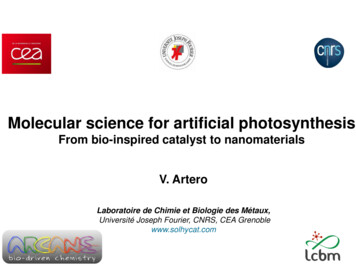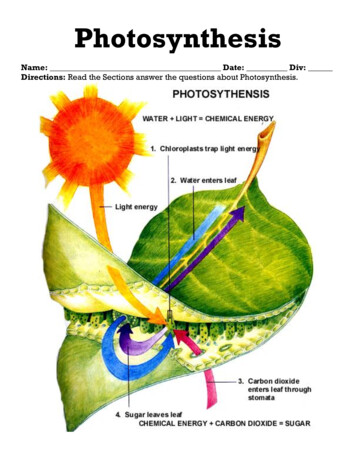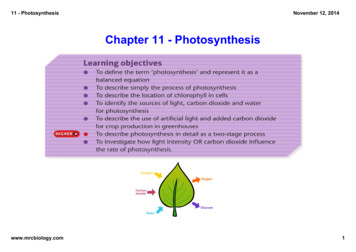
Transcription
Molecular science for artificial photosynthesisFrom bio-inspired catalyst to nanomaterialsV. ArteroLaboratoire de Chimie et Biologie des Métaux,Université Joseph Fourier, CNRS, CEA Grenoblewww.solhycat.com
AcknowledgementsMarc FontecaveMurielle Chavarot-KerlidouJennifer FizePhD studentsNicolas QueyriauxNicolas KaefferMarine BacchiSigolène CanaguierRomain MétayéYohan OudartPost-docsCarole BaffertAziz FihriPierre-André JacquesAlan Le GoffMathieu RazavetPhong Tran DinhVincent FourmondSaioa CoboEugen S. AndreiadisTrevor R. SimmonsGustav Berggren23 SEPTEMBRE 2013CollaborationsIBSMartin Field (DFT)Ibitech-SWinfried LeiblINACColette Lebrun (ESI-MS)Jacques Pécaut (X-Ray)LITENNicolas GuilletAlexandre PereiraLaure GuetazIRAMIS (surface chemistry)Serge PalacinBruno JousselmeDalian Univ.of TechnologyLicheng SunMei WangZhan PanFrei Universität BerlinHolger DauJonathan HeidkampNTU SingapourPhong. D. TranLETIMurielle MatheronIPCM- Univ. Paris 6Anna ProustGuillaume IzzetLCMCP- Univ. Paris 6Christel Laberty-RobertClément Sanchez
The global energy challengeca 125 TWAnnual global photosynthesisSolar per hourSolar influx on Earth 120 000 TW 1h corresponds to our yearly consumptionNuclearBiomassHydroothers80%2010; ca 17 TWFossilFuel 83%Electricity 17%Need for chemicalenergy storage2050; ca 30 TWFossil01023 SEPTEMBRE 201320TW3040
Renewable energy: SolarRenewable energy- Concentration- Storage (fuels)Hydrogen (H2)production23 SEPTEMBRE 2013Li-ion batteries:Oil:Hydrogen:CO2 recycling andproduction of liquid fuels0.46 - 0.72 MJ.kg-147 MJ.kg-1140 MJ.kg-1
SOLAR FUELSConverting solar energy into chemical energyNatural photosynthesisPhoto-Electrochemical CellPhotovoltaic devicePV electrolysisState of the art « PV Electrolysis » technology23 SEPTEMBRE 2013
PV electrolysisWired PV Electrolysis Robust- Mature ( 18%) 3 devicesPVElectrolysis cellPower managementPeharz IJHE 2007Janssen Adv. Mater. 2013Unwired PV ElectrolysisTurner Science 1998Nocera Science 2011h 7.8%23 SEPTEMBRE 20137200 h Single device Stability of PV materials into electrolyte One fixed operating point
SOLAR FUELSConverting solar energy into chemical energyH2OH2MicroalgaeNatural photosynthesisPhoto-ElectrochemicalArtificial photosynthesisCellAbundant and cheap materials bothfor light harvesting and catalysisSustainabilityEconomic viability23 SEPTEMBRE 2013Photovoltaic devicePV electrolysisState of the art « PV Electrolysis » technologyFundamental research to TRL 2
Solar Fuels: a transversal fieldMn2H2Oa-Fe2O3CoSolid-state materialsO2 4H H H2Molecular chemistryNanosciencesPBiosciencesPhotosynthesis23 SEPTEMBRE 2013H2OMnMnMnMnO2
: an international initiativewww.solar-fuels.orgThe product:The method:Light captureWater splittinga solar liquid fuelbeing global and harnessthe intellectual firepower ofgovernment-funded researchinstitutions and R&D industryDriven academic research will lead tosimultaneousindustryR&Dandcommercially-viable productsCO2 catalysisThe tools:workshopsmap of knowledgefellow-exchange programstranslational prize (grants)
AMPEA : a Joint program of theEuropean Energy Research AllianceAdvanced Materials and Processes for Energy Applications43 participant/associate institutions14 EU countriesThis JP is structured as a matrix with 3 “tools” sub-programmes:SP1 : Materials Science.SP2 : Characterization of materials and processes.SP3 : Modelling of materials and processesand “emerging applications,” among whichArtificial Photosynthesis appears as a first objectiveCurrent activities in Artificial Photosynthesis mightbe grouped into three subfields: molecularly designed systems solid-state components nature-guided designThapper et al., Green 2013, 3, 43.
CM 1202 “Perspect-H20”: a COST Actionon Supramolecular water splitting:www.perspect-h2o.eu21 countries55 research groupsChair: Dr Benjamin Dietzek, IPHT-JENA fundamental understanding of the function determining light-induced elementaryreactions in supramolecular photocatalytic water-splitting novel water-splitting supramolecular photocatalysts innovative functional systems operating in solutions, membranes or at surfacesWorking groups1. Synthesis and Photocatalysis2. Device Integration3. Photoinduced Dynamics4. Intermediates & Active Species23 SEPTEMBRE 2013
Photosynthesis1. Conversion of light energyinto electrochemical potentialmicro-algaePhoton absorption and initial chargeseparation is achieved by molecularphotosensitizersSpatial charge separation through acascade of electron transfers2. Efficient multielectronenzymatic catalysisFastClose to the thermodynamicequilibrium (limited energetic loss)23 SEPTEMBRE 2013Dye-sensitized solar cells (Grätzel cells)1.0µmOrganic photovoltaics
The biomimetic approachH H2Canaguier et al. Chem. Commun 2010, 46, 5876NiFe hydrogenasesCODH and formate reductaseFeFe and NiFe hydrogenasesCaMn4 Cluster (OEC)
Bio-inspiration: Cobaloxime and cobaltdioxime-dioxime catalysts 55 0000 TONspH 4.5 acetate buffer300 mV overpotentialMolecular engineering of a cobalt-basedelectrocatalytic nanomaterial for H2 evolutionunder fully aqueous conditionsJacques et al, PNAS 2009Bhattacharjee et al. Chem. Eur. J. 2013E. S. Andreiadis et al. Nature Chemistry, 2013also valid for with Ni catalysts (Le Goff et al. Science 2009)
Cobaloxime-based supramolecularphotocatalysts½ H2eEt3N 100 turnoversH Et3NSingle light-driven electron transfer (ps-ns)Bi-electronic catalysis (µs-ms)Fihri et al. Angew. Chem. Int. Ed. 2008Review articleArtero, Chavarot-Kerlidou, Fontecave, Angew. Chem. Int. Ed. 2011
Charge photoaccumulation : towardsimproved systemsCollab. G. Izzet A. Proust, IPCM, Univ Paris 6Energy Environ. Sci. 2013, 6, 1504e-Et3N 6- 7- 8-½ H2Et3Ne-NP ?Polyoxometallate:electron reservoirEt3N Et3NH
Towards Dye-Sensitized PhotoElectrosynthetic Cells (DSPEC)PEC cells use renewable ressources (water) to sustainablyproduce a fuel (H2) and store renewable energy (sunlight)H2N. Lewis, Chem. Rev 2010T. J. Meyer, Nature Chemistry 2011O2photocatalystsurfacePhotoanode materiale-
Towards Dye-Sensitized PhotoElectrosynthetic Cells (DSPEC)PhotocathodeLicheng Sun and coll. Chem.Comm. 2012PhotocathodeYiying Wu and coll. JACS 2013PhotoanodeLicheng Sun and coll. JACS. 2013e-h
Combining Organic Photovoltaics with watersplitting catalysis1N aq. H2SO4MoS3/TiO2Collab. B. Jousselme, S. Palacin CEA-SaclayEnergy Environ. Sci. 2013, 6, 2706 600 mV photopotential 200 mV overpotential
ConclusionProgresses towards a mature hydrogen economy depends onbreakthroughs in finding new catalytic materialsBiological systems provide the synthetic chemist with both challengesand inspiration regarding the design of new and efficient catalyticsystems.One of nature's most fundamental processes – photosynthesis – holdspromises for turning the sun's energy into fuels.Combining the bio-inspired approach with nanochemical tools, new andstable energy conversion materials based on earth-abundant elementscan be derived.
Chair: Dr Benjamin Dietzek, IPHT-JENA . 23 SEPTEMBRE 2013 1. Conversion of light energy into electrochemical potential Photon absorption and initial charge separation is achieved by molecular photosensitizers Spatial










